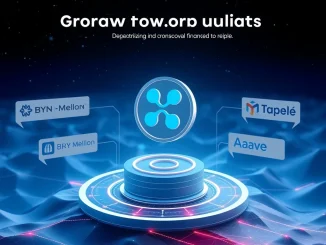
South Korea, a nation renowned for its technological prowess and fervent adoption of digital trends, is witnessing a surge of interest in the cryptocurrency realm. As the country gears up for its presidential elections, one candidate is stepping into the spotlight with a visionary approach to digital finance. Hong Joon-pyo, a prominent contender from the People Power Party, has ignited excitement within the crypto community by announcing his intent to explore the introduction of a central bank digital currency (CBDC) and a Korean won-backed stablecoin. This move signals a potentially transformative shift in South Korea’s digital economy and its stance on cryptocurrencies.
Why is Hong Joon-pyo’s CBDC and Stablecoin Stance a Game Changer for South Korea Cryptocurrency?
Hong Joon-pyo’s proactive stance on CBDC and stablecoin is not just another political promise; it’s a strategic move to address critical challenges and unlock new opportunities for South Korea’s digital future. His announcement comes at a time when global interest in digital currencies is skyrocketing, and nations worldwide are exploring the potential of CBDCs. For South Korea, a nation striving to maintain its competitive edge in the digital landscape, embracing these technologies could be pivotal.
Unpacking the Promise: CBDC and Digital Won
At the heart of Hong’s digital finance agenda lies the concept of a CBDC, specifically, a potential digital won. But what exactly is a CBDC, and why is it generating so much buzz?
- Central Bank Digital Currency (CBDC) Explained: Imagine a digital form of a nation’s fiat currency, issued and regulated by the central bank. That’s essentially what a CBDC is. Unlike cryptocurrencies like Bitcoin or Ethereum, which are decentralized, a CBDC operates under the control of the central monetary authority.
- Digital Won: South Korea’s Potential CBDC: Hong Joon-pyo’s proposal hints at exploring the creation of a digital won, a CBDC tailored for South Korea. This digital won could revolutionize how Koreans transact, offering a secure, efficient, and potentially cost-effective alternative to traditional payment methods.
- Benefits of a CBDC:
- Enhanced Payment Efficiency: CBDCs can streamline payment systems, making transactions faster and cheaper, especially for cross-border payments.
- Financial Inclusion: By providing access to digital currency, CBDCs can bring the unbanked and underbanked populations into the formal financial system.
- Reduced Illicit Activities: Digital transactions through a CBDC can be more transparent, potentially curbing illicit activities like money laundering.
- Monetary Policy Innovation: CBDCs could offer central banks new tools to implement monetary policy and respond to economic fluctuations.
Stablecoin on the Horizon: A Korean Won-Pegged Cryptocurrency
Beyond CBDC, Hong Joon-pyo’s vision extends to the realm of stablecoins, specifically a stablecoin pegged to the Korean won. Stablecoins have gained traction in the crypto world for their ability to offer the stability of traditional fiat currencies with the flexibility and efficiency of blockchain technology.
- What is a Stablecoin?: A stablecoin is a cryptocurrency designed to maintain a stable value, typically pegged to a fiat currency like the US dollar or, in this case, the Korean won. This pegging mechanism aims to mitigate the price volatility often associated with other cryptocurrencies.
- Korean Won-Based Stablecoin: Bridging Fiat and Crypto: The issuance of a Korean won-based stablecoin could serve as a crucial bridge between the traditional financial system and the burgeoning crypto market in South Korea. It could offer users a less volatile entry point into the crypto space, fostering wider adoption and innovation.
- Potential Advantages of a Won-Pegged Stablecoin:
- Stability in Crypto Transactions: For Korean users engaging in cryptocurrency trading or payments, a won-pegged stablecoin can provide a stable medium of exchange, reducing exposure to market fluctuations.
- Facilitating Fintech Innovation: A readily available and stable digital representation of the Korean won can spur innovation in the fintech sector, enabling new applications and services.
- Cross-Border Transactions: Stablecoins can simplify and reduce the costs associated with international transactions, benefiting businesses and individuals involved in global trade.
Addressing the “Digital Galapagos”: Cutting Regulations for Fintech Growth
Hong Joon-pyo’s commitment to exploring CBDC and stablecoin is intertwined with a broader goal: dismantling South Korea’s “digital Galapagos” status. This term highlights the regulatory hurdles that have inadvertently isolated the domestic digital market, hindering access to foreign digital services and platforms for Korean users.
The “Digital Galapagos” Challenge
South Korea, while a tech powerhouse, has faced criticism for regulations that some argue have stifled innovation and limited consumer choice. These restrictions, intended to protect domestic industries, have ironically created a closed-off digital ecosystem, resembling the isolated Galapagos Islands in terms of digital evolution.
Regulatory Reform for a Thriving Digital Economy
Hong’s pledge to cut “unnecessary regulations” in the fintech and digital sectors signals a welcome shift towards a more open and competitive digital environment. This regulatory reform is crucial for:
- Fostering Fintech Innovation: By easing regulatory burdens, South Korea can attract more fintech startups and encourage established players to innovate and experiment with new technologies, including blockchain and cryptocurrencies.
- Enhancing Consumer Access: Reducing restrictions can grant Korean users access to a wider range of global digital services and platforms, fostering a more vibrant and interconnected digital experience.
- Boosting Global Competitiveness: An open and innovative digital economy can strengthen South Korea’s position as a global leader in technology and finance.
The Road Ahead: Challenges and Opportunities
While Hong Joon-pyo’s visionary plans for CBDC and stablecoin are undoubtedly exciting, the journey ahead is not without its challenges. Implementing a CBDC and fostering a thriving stablecoin ecosystem require careful consideration of various factors, including:
| Challenges | Opportunities |
|---|---|
| Security and Cybersecurity: Ensuring the security and resilience of CBDC and stablecoin systems against cyber threats is paramount. | Technological Advancement: Driving innovation in blockchain and cryptography technologies to build robust and secure digital currency infrastructure. |
| Privacy Concerns: Balancing the transparency of digital currencies with the need to protect user privacy is a delicate task. | Building Trust: Establishing clear regulatory frameworks and governance structures to build public trust in CBDCs and stablecoins. |
| Regulatory Framework: Developing comprehensive and adaptable regulations that foster innovation while mitigating risks is crucial. | Global Collaboration: Engaging in international dialogues and collaborations to shape global standards for CBDCs and digital assets. |
| Adoption and Education: Ensuring widespread adoption and educating the public about the benefits and risks of CBDCs and stablecoins is essential for success. | Economic Growth: Leveraging CBDCs and stablecoins to enhance payment systems, boost financial inclusion, and drive economic growth in South Korea. |
Conclusion: A Bold Step Towards South Korea’s Digital Future
Hong Joon-pyo’s embrace of CBDC and stablecoin represents a bold and potentially transformative step for South Korea’s digital future. By addressing the “digital Galapagos” challenge and championing innovation in fintech, he is signaling a commitment to positioning South Korea at the forefront of the global digital economy. As the nation moves closer to its presidential elections, the crypto community and the wider public will be keenly observing how these visionary plans unfold and whether they translate into a new era of digital prosperity for South Korea.



